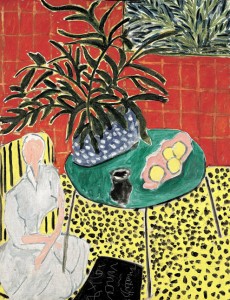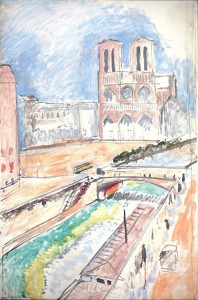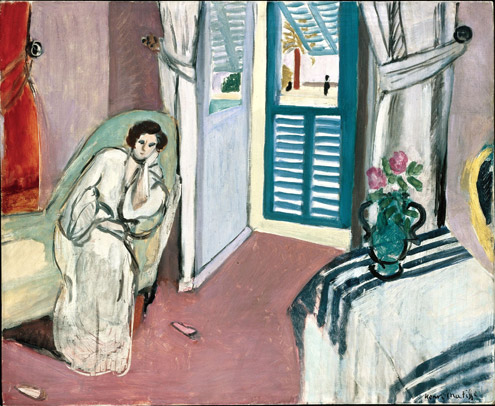Henri Matisse and my journey to discover the meaning of art
Picture this: I’m cleaning up post holiday season – yeah, it took me a long time to let go – and I come across a strand of Christmas lights.
I plug them into the wall and about half the string lights up. I follow the cord away from the wall to the other side of the room, holding the lights up off the ground. It looks like a glorified clothes line. I lower it to the ground slowly and it makes a small pattering crash.
I lift them up and let them drop again.
Crash.
I pick them up again and swing them from side to side. It reminds me of jump rope in elementary school. I swing it from side to side and then I loop it around, creating a jump rope arc.
I wish someone else were here to play double dutch with me. I let the strand crash to the floor. I should twist them up in a somewhat organized pile. Instead I crawl onto my belly and hold the lights up over my head with my hands and feet, making the P90x Superman pose with my body.
It looks like I’m dangling from the lights in the reflection I can see of myself in the window. I turn over onto my back (making the P90x banana pose with my body and still holding the lights up with my hands and my feet). Still hanging from the lights. Hammock style. I stand up with the lights and hold them up over my head to create a rectangle around me. It looks like a door frame and I step through it.
I make the rectangle again and step through again. And again. And again. It feels like I’m entering a portal to a different world each time – like visiting a new realm of Narnia. Finally, I step through a doorway and let the rectangle of lights fall behind me, draping around my neck.

I drag the lit strand hanging off from either shoulder and it looks as though I have a lit cape. I am queen of the other worlds I’ve just created. I try to sit regally on the ground, but I lose my balance and crash with the lights. They get tangled around me. Around my neck, arms, and legs, and suddenly the world I ruled, rules me. I’m imprisoned and trapped. Then the lights go out. …I busted the strand in my playing.
That’s a small movement piece as BIZARRE as it sounds. And for me that’s creating. It’s movement oriented improvisation with an object. And it’s a process. Tomorrow I could pick up the same strand of lights and do something completely different with it.
I feel pretty foolish as a young artist a lot of the time. I don’t have a ton of experience. I don’t know exactly what I’m doing. A lot of what I create is off the cuff, new, fresh, and dependent on my technique. I’m really starting to understand that I have to develop my own artistic process. I think it’s really quite lovely that each artist has their own. Some actors swear by method acting (sleeping on a park bench in order to play a homeless man).

Others rely on sense memory, recollecting situations from their childhood to reach an emotional state and working from the inner thoughts to then reach out to the audience. I approach things physically. Working with the body from the outside in. It’s all relative. It just depends on what works best for the artist.
I was at the Metropolitan Museum of Art over the weekend and saw the Henri Matisse exhibit that’s there through March 17. It was incredible to watch how Matisse (1869–1954) would paint several canvases of the same thing – be it a beach, a still life, a portrait. He would paint it several times, but always shift it so there were eels on the beach, and then fish on the beach, and then a ray on the beach. And the beach would be purple in one painting, speckled orange in another, and yellow in another.
In this way, each painting was its own painting, but each painting was also refining the scene to ultimately create a final piece he would reveal in a show in Paris.
I found it completely fascinating to watch how he worked from one canvas to the next to the next. They were all dated so on Jan 13, he would paint a canvas of a woman with a large, fluffy dress. On Jan 18, the dress would be slimmer. On Jan 20, the dress would have a white design on it. To look at all of the paintings next to each other I felt like I was playing one of those picture games where I had to notice what was missing or added to image 1 from image 2.
It might have been a little OCD. For Matisse to go over it and over it and over it. Changing it and tweaking it. And yet, that’s how he got to where he wanted to go. That’s what worked for him. That was his creating. His making. His art.

And he must have enjoyed it, because he spent a lot of time doing it.
So I think my lesson to draw from him is that art is an extensive process, which makes the process not only necessary, but worth finding. Because the creating is in the process. Not the product.
I think in life it’s easy to want to reach the end goal. To be the most amazing thing – whatever that means – ever. To accomplish xyz. Sometimes I find myself thinking I’ll let myself enjoy abc if, and only if, I accomplish xyz. But what if I accomplish xyz on my deathbed or after I die (life time achievement award anyone)? What if there isn’t time to enjoy abc?
And what if abc is actually needed for xyz? What if it’s actually part of the process? The technique. The discovering. What if it’s playing with a string of lights – whether it becomes a product or not?
I guess it’s like they say: the joy is in the journey


Jana (it rhymes with “banana” or “anna”) is an artist from Clarksville, Maryland. Growing up her parents always told her to “be whatever you want to be.” Seeing as she has come from three generations of doctors, she obviously became an artist. As an actor, she has performed internationally Off-Broadway, and locally to the Baltimore/DC area. Favorite roles include Juliet, Ariel, and Caliban. Jana is the Founder of Red Connect Online, a social media marketing company that creates customized advertising campaigns for small businesses. You can listen to her podcast, Confessions of a Closet Christian, on the E-Squared Media Network. You can also follow her on Twitter (@Jana_Stambaugh) and friend her on Facebook.

